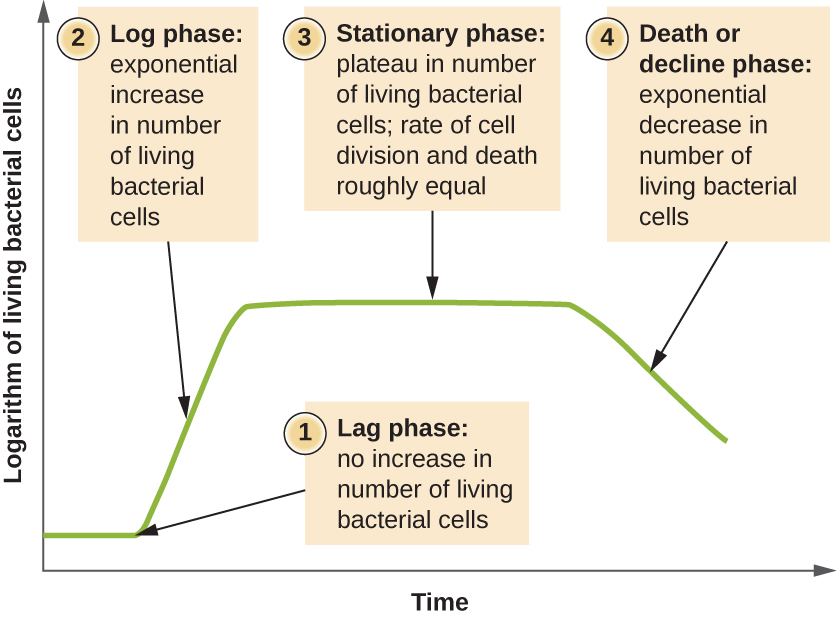Explain Why Is Growth in Bacteria Different Than in Human
Such a phase of growth in bacteria is attained at a population level of around 10 9 cells per ml. These microbes can be found in.

How Microbes Grow Microbiology
Different bacteria are adapted to different salt concentrations.

. Agar 15 if the salt concentration is LOW-lysis of cell-if the salt concentration is high-. In contrast in unicellular organisms cell multiplication leads to increase in number of individuals in a population ie. Although bacteria are good at adapting to their environments certain conditions promote bacterial growth more than others.
Milk from a healthy cow initially contains very few bacteria which primarily come from the skin of the cow and the procedures for handling the milk. Despite the distinctions in bacterial compositions between the two groups of human-derived microbiotas there were no apparent differences in the growth and division patterns of the same bacterial species in the two groups which further verified the results of the growth patterns of human gut bacteria obtained in our study. Oxygen is not very soluble and may be.
Summer months typically have longer days with more sunshing providing photosynthetic organisms with ample supplies of their energy source. Acidic environments have pH values that are less that 7 neutral environments have values at or near 7 and basic environments have pH values greater than 7. With each division cycle generation one cell gives rise to 2 cells then 4 cells then 8 cells then 16 then 32 and so forth.
Occurs mainly by binary fission. The ceasation of growth may be because of the exhaustion of available nutrients or by the accumulation of inhibitory end products of metabolism. For example going from a tiny newborn baby to a large adult.
In addition the warmer temps allow faster growth of bacteria. The ceasation of growth may also be due to O 2 availability particularly in case of aerobes. Jacques Monod a pioneer in the study of bacterial growth kinetics first demonstrated the relationship between limiting nutrient concentrations and bacterial growth.
U Most bacteria divide every 1 to 3 hours. The growth of a bacterial population occurs in a geometric or exponential manner. With respect to humans the term growth refers to an increase in size.
So for bacteria majority of them being unicellular organisms growth may be defined as the. The importance of bacteria to humans Bacteria in food. Understanding the optimal conditions for bacterial growth can.
Microbial Growth Growth of Bacterial Cultures Bacterial Division. Generation time varies considerably. A few bacterial species reproduce by budding.
Bacterial growth can spoil. -Halotolerant DO NOT require but can adapt to high salt concentrations 2. Bacteria that are acidophiles thrive in areas where the pH is less than 5 with an optimal growth value close to a pH of 3.
Generation TimeTime required for a cell to divide and its population to double. In multicellular organisms this increase in cell number leads to increase in size because the daughter cells remain together. As we mentioned earlier the most prominent point of difference between these two is the fact that aerobic bacteria require oxygen to survive while anaerobic bacteria dont.
These conditions include temperature moisture pH and environmental oxygen. This can be attributed to the fact that aerobic species have the ability to detoxify oxygen. Milk is an excellent growth medium for numerous bacteria and the bacteria can increase rapidly in numbers unless the milk is properly processed.
- Halophiles grow at high salt concentrations. Coli divides every 20 minutes. Another important factor for bacterial growth is pH.
Cyanobacteria are photosynthetic meaning that they are photoautotrophs which harvest their energy from sunlights. Although bacteria do increase in size before cell division bacterial growth refers to an increase in the number of organisms rather than an increase in their size. Bacteria grow in very diverse conditions which explains why they are found nearly everywhere on Earth.
Growth of bacterial cultures is defined as an increase in the number of bacteria in a population rather than in the size of individual cells. In defined medium in which all but one isolated nutrient was provided in excess he demonstrated that total growth or bacterial growth yield is linearly dependent on the.

No comments for "Explain Why Is Growth in Bacteria Different Than in Human"
Post a Comment